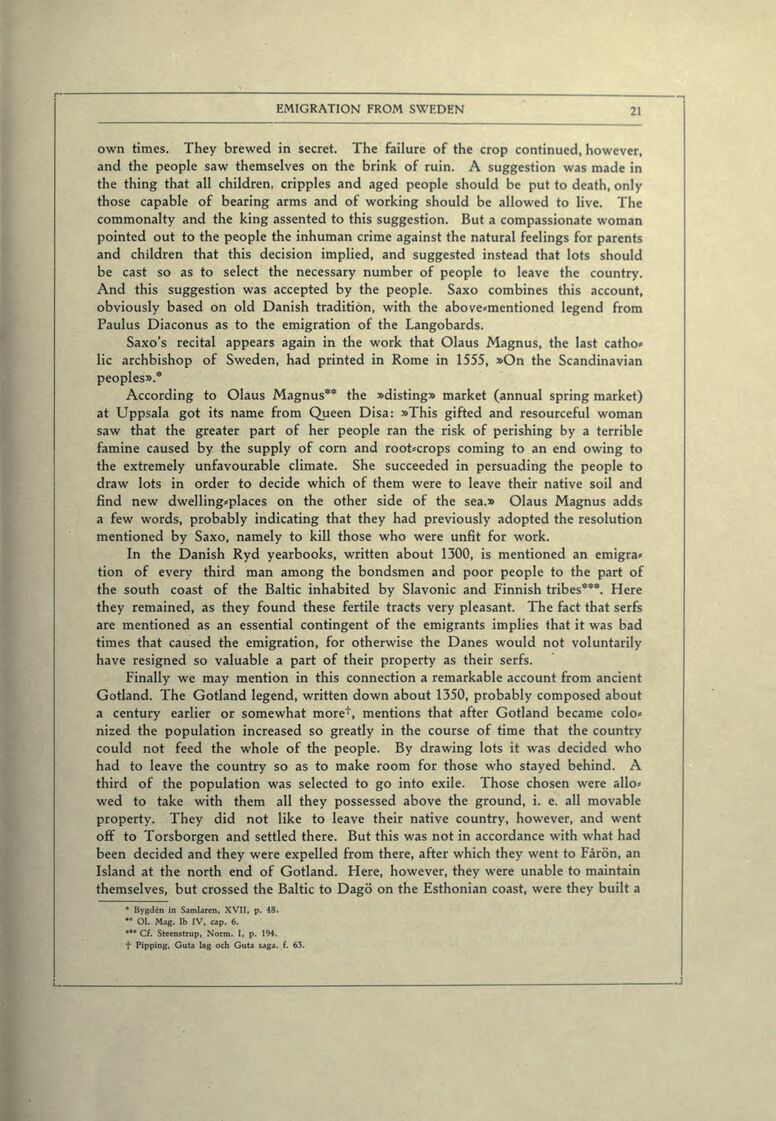
Full resolution (JPEG) - On this page / på denna sida - Part I - Professor Otto von Friesen, Uppsala, Emigration from Sweden in Ancient Times

<< prev. page << föreg. sida << >> nästa sida >> next page >>
Below is the raw OCR text
from the above scanned image.
Do you see an error? Proofread the page now!
Här nedan syns maskintolkade texten från faksimilbilden ovan.
Ser du något fel? Korrekturläs sidan nu!
This page has never been proofread. / Denna sida har aldrig korrekturlästs.
I–––––––––––––––––––––––––––––-—––––––––––
EMIGRATION FROM SWEDEN 21
own times. They brewed in secret. The failure of the crop continued, however,
and the people saw themselves on the brink of ruin. A suggestion was made in
the thing that all children, cripples and aged people should be put to death, only
those capable of bearing arms and of working should be allowed to live. The
commonalty and the king assented to this suggestion. But a compassionate woman
pointed out to the people the inhuman crime against the natural feelings for parents
and children that this decision implied, and suggested instead that lots should
be cast so as to select the necessary number of people to leave the country.
And this suggestion was accepted by the people. Saxo combines this account,
obviously based on old Danish tradition, with the above*mentioned legend from
Paulus Diaconus as to the emigration of the Langobards.
Saxo’s recital appears again in the work that Olaus Magnus, the last catho*
lic archbishop of Sweden, had printed in Rome in 1555, »On the Scandinavian
peoples».*
According to Olaus Magnus** the »disting» market (annual spring market)
at Uppsala got its name from Queen Disa: »This gifted and resourceful woman
saw that the greater part of her people ran the risk of perishing by a terrible
famine caused by the supply of corn and root*crops coming to an end owing to
the extremely unfavourable climate. She succeeded in persuading the people to
draw lots in order to decide which of them were to leave their native soil and
find new dwelling*places on the other side of the sea.» Olaus Magnus adds
a few words, probably indicating that they had previously adopted the resolution
mentioned by Saxo, namely to kill those who were unfit for work.
In the Danish Ryd yearbooks, written about 1300, is mentioned an emigra*
tion of every third man among the bondsmen and poor people to the part of
the south coast of the Baltic inhabited by Slavonic and Finnish tribes***. Here
they remained, as they found these fertile tracts very pleasant. The faet that serfs
are mentioned as an essential contingent of the emigrants implies that it was bad
times that caused the emigration, for otherwise the Danes would not voluntarily
have resigned so valuable a part of their property as their serfs.
Finally we may mention in this connection a remarkable account from ancient
Gotland. The Gotland legend, written down about 1350, probably composed about
a century earlier or somewhat more’1’, mentions that after Gotland became colo*
nized the population inereased so greatly in the course of time that the country
could not feed the whole of the people. By drawing lots it was decided who
had to leave the country so as to make room for those who stayed behind. A
third of the population was selected to go into exile. Those chosen were allo*
wed to take with them all they possessed above the ground, i. e. all movable
property. They did not like to leave their native country, however, and went
off to Torsborgen and settled there. But this was not in accordance with what had
been decided and they were expelled from there, after which they went to Fårön, an
Island at the north end of Gotland. Flere, however, they were unable to maintain
themselves, but crossed the Baltic to Dagö on the Esthonian coast, were they built a
• Bygdén in Samlaren, XVII, p. 48.
•* Ol. Mag. Ib IV, cap. 6.
*** Cf. Steenstrup, Norm. I, p. 194.
t Pipping, Guta lag och Guta saga. f. 63.
<< prev. page << föreg. sida << >> nästa sida >> next page >>